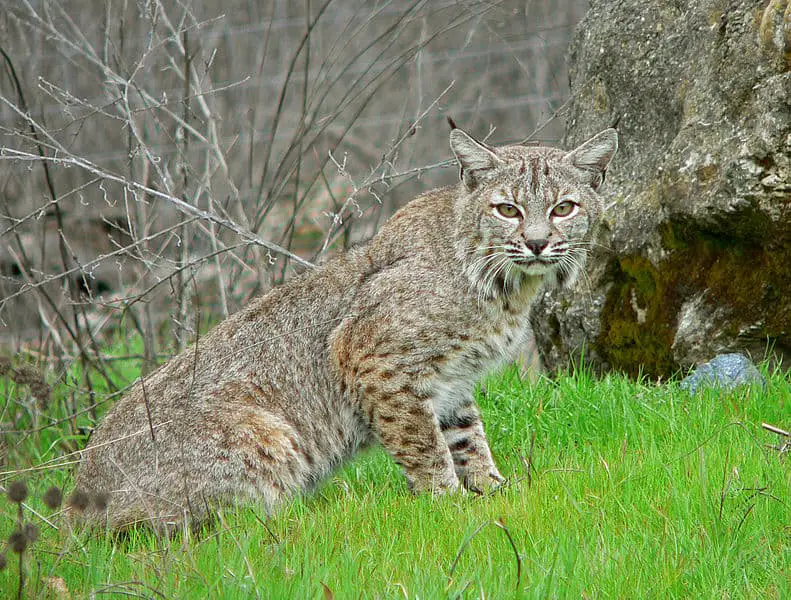Are there wild cats in Florida? The answer is Yes. The Sunshine State has two different native species of wildcats, the bobcat and the Florida panther. Additionally, the state of Florida has a huge population of non-native feral cats.
Discover the wild cats of Florida: the elusive bobcat, endangered Florida panther, and the impact of feral cats. Learn about their habitats, behaviors, and conservation efforts.
Bobcats in Florida (Lynx rufus)
The Florida bobcat, sometimes called the Florida lynx, is actually a species of lynx related to the Canada lynx. It is exclusively a North American wild cat and is also the most common wild cat species in North America.
Biologists believe that both the bobcat and the Canada lynx are descendants of the Eurasian lynx, and their ancestors crossed into North America via the Bearing Sea land bridge.
Where Do Bobcats Live?
These small wild cats live in three North American countries. Their range begins in southern Canada and extends south through most of the United States and into central Mexico.
Bobcats vs. Lynx: Snow Adaptations
The bobcat lacks some of the adaptations that enable its cousin, the Canada lynx, to thrive in deep snow. An example of this is a lynx’s fury oversized paws. Consequently, the bobcat range fades out in Southern Canada. Lynx populations are denser the further north one travels into Canada.
Bobcats in Florida
The Florida bobcat population is distributed throughout all 67 of the state’s counties. They inhabit deep forests, swamps, semi-forested areas, agricultural zones, and even urban environments. These feline predators are mostly crepuscular or nocturnal, but it’s not uncommon to see one in the daytime because they only sleep for 2 to 3 hours at a time.
Territory and Behavior
Bobcats are solitary and territorial animals, with males claiming home ranges of over 10 square miles. In contrast, female home ranges can be less than 1 square mile. Interestingly, male and female ranges may overlap, especially during mating season. They patrol and scent-mark their territories using urine and feces to ward off intruders.
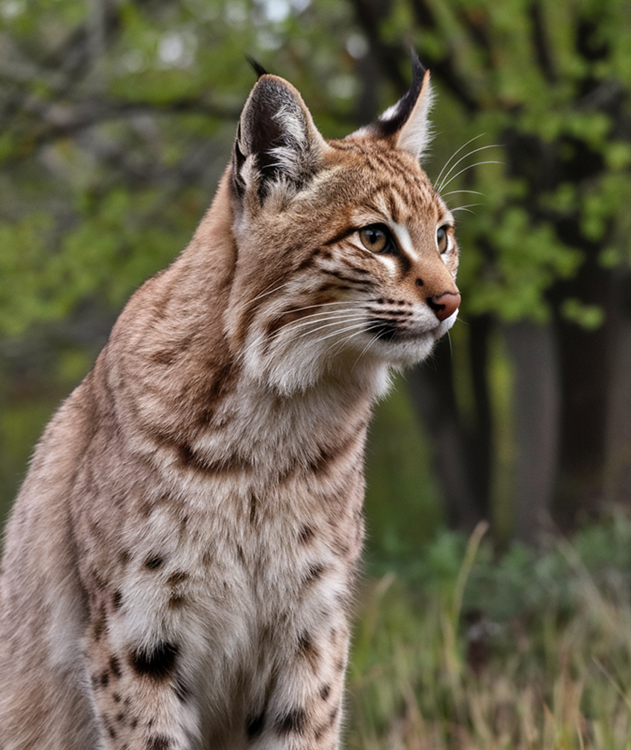
What Do Bobcats Look Like?
Bobcats are smaller than mountain lions and slightly smaller than Canada lynx, with smaller female bobcats being only slightly larger than large domestic cats. Here’s a detailed breakdown of their physical characteristics:
- Size and Weight:
- Length: 2 to 3 feet.
- Weight: Typically between 15 to 35 pounds, with females significantly smaller than males.
- Tail and Body Markings:
- Short, “bobbed” tail with a distinctive black tip.
- Fur color: Ranges from gray to brown, with mottled dark spots in shades from black to dark brown.
- Markings: Black stripes are visible on their inner forelegs and tails.
- Body Shape:
- The rump sits slightly higher than the shoulders, giving them a unique profile.
- Long hind legs compared to shorter forelegs, similar to the structure seen in lynx.
- Ear and Facial Features:
- Ear tufts: Black tufts of hair that rise above each ear.
- Earbacks: Black with a central white spot, creating a “false eye” appearance.
- Face: Broad and whiskered, with long, ruffled facial hair enhancing the width of their face.
- Eyes: Yellow or greenish-yellow with black, vertical elliptical pupils.
These unique physical traits make bobcats distinct in appearance, helping them adapt to various environments with excellent camouflage.
Black bobcats, more precisely termed melanistic bobcats, are very rare, but they do occur in Florida. These animals have the same markings as regular bobcats, but they are darker black on top of a grey background.
“On a side note, what people term as a black panther is actually either a melanistic jaguar or a melanistic leopard.”
What Do Bobcats Eat in Florida?
Florida bobcats are aggressive predators, capable of taking down prey larger than themselves, including:
- Wild hogs
- White-tailed deer
Their regular diet primarily includes:
- Small mammals such as eastern cottontails, swamp rabbits, and various rodents.
- Reptiles
- Birds
- Insects
- Carrion
When near residential areas, they may occasionally prey on:
- Small livestock, such as goats or chickens
- Small pets
A fun fact- Bobcats even use venomous snakes as a food source when the opportunity arises despite not being immune to their venom. They accomplish this by using their quickness to pin the snake’s head down with a paw, then dispatch it with a quick bite to its spine behind the head. Florida has six venomous snake species.
Reproduction and Life Cycle for Bobcats
Bobcat Mating Season and Gestation Period
Bobcats mate anywhere in February and March. During the breeding season, a male bobcat may mate with multiple females. If they successfully mate, the gestation period for bobcats is 60 days.
Denning Sites for Bobcat Mothers
After breeding, the male and female go their separate ways. The female takes all responsibility for the selection of a den site and the rearing of the young. Females generally give birth between late April and early May. See
Bobcats use features such as a rock outcropping, an opening in the ground, the cavity beneath an overturned stump, or the space beneath a blown-down tree as denning sites.
Average Litter Size and Kitten Development
The average bobcat litter size is three kittens. Bobcat kittens are born with their eyes sealed, just like domestic cats are. However, their eyes will open when they are a week to 10 days old. By the time they are 2 months old, they will have replaced their spotted baby fur with a haircoat similar to what their parents have.
Kittens’ Training and Independence
By mid-July, the kittens venture out with the mother bobcats to fine-tune their survival skills. Their training may last into the early winter. By mid-winter, the kittens strike out on their own.
Age of Sexual Maturity in Bobcats
Female bobcats reach sexual maturity at 1 year of age, while males reach sexual maturity at age 2.
Typical Lifespan of Wild Bobcats
In the wild, the average life span of a bobcat is 7 to 10 years. See
Hunting and Trapping Florida Bobcats
Hunting and trapping bobcats is legal in Florida. See here for more information.
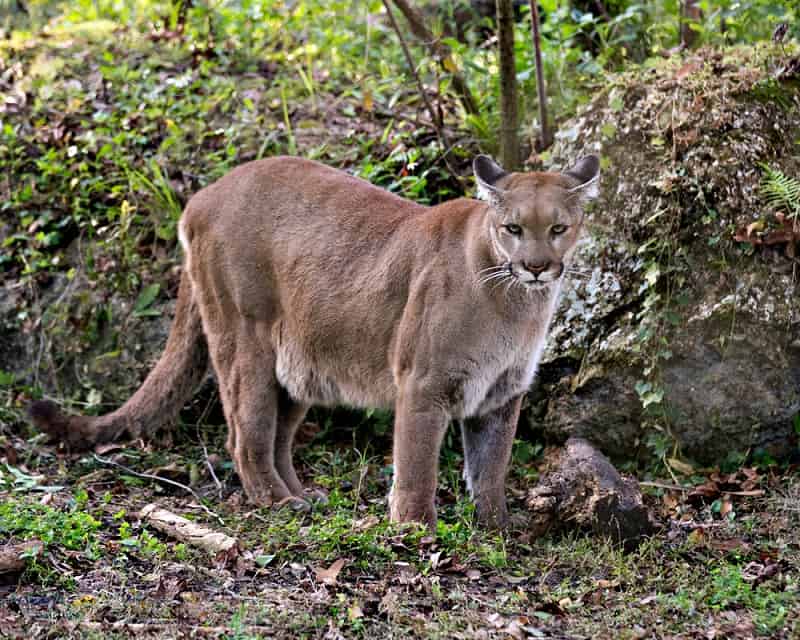
Florida Panther (Puma concolor cougar)
The Florida Panther is a rare subspecies of the mountain lion that lives primarily in southwest Florida. It is the only cougar population east of the Mississippi. Today, around 200 Florida Panthers are estimated to remain in the wild.
Endangered Status and History
The Florida Panther was one of the first animals protected by the Endangered Species Act of 1973. Before European settlement, these big cats roamed across eight southeastern states. However, a bounty was placed on them in 1832 due to conflicts with livestock and other wildlife, which led to a drastic decline in their numbers. By the 1950s, they were believed to be extinct until a small population was rediscovered in South Florida in 1973, prompting federal protection efforts.
Efforts to Combat the Effects of Inbreeding
By the early 1990s, only 20 to 30 Florida panthers were left in the wild. Stemming from such a small gene pool, these animals suffered from severe problems.
Recessive genetic conditions that would otherwise stay hidden are expressed more often in highly inbred animals. The remaining Florida panthers had a high incidence of several deleterious genetic conditions.
- One of these genetic conditions was ASD (Atrial Septal Defect). This is a heart defect that allows blood to flow between the heart’s top two chambers.
- Another genetic condition that researchers found prevalent in Florida’s panther population was cryptorchidism. A cryptorchid male has either one “unilateral” or two “bilateral” undescended testicles. A bilateral cryptorchid male is incapable of reproducing. Male Florida panthers also had low sperm counts and low sperm quality.
- The panthers surveyed in the early 1990s were also observed carrying extremely high parasite loads due to an impaired immune response.
Conservation biologists with the Florida Fish and Wildlife Conservation Commission determined that introducing outside genes into the existing genetic base would improve the overall fitness of the remaining animals. Consequently, in 1995, they released eight female cougars from Texas into the Florida panther recovery area.
This injection of outside genes into the population produced an overall improvement in the fitness of the group. By 2008, the Florida panther population had quadrupled to around 120 animals. See
Taxonomic Classification
These cats were designated a distinct cougar sub-species with the scientific name, (Puma concolor coryi) by the American zoologist Outram Bangs in 1899. However, mitochondrial DNA analysis performed in 2006 showed that many of the cougar sub-species described in the 19th century were too closely related to be considered distinct sub-species. At that time, Florida Panthers received the scientific sub name, North American cougar or (Puma concolor couguar). Subsequently, in 2017, the Cat Specialist Group’s Cat Classification Taskforce reclassified all North American mountain lion populations into the subclass (Puma concolor couguar). See
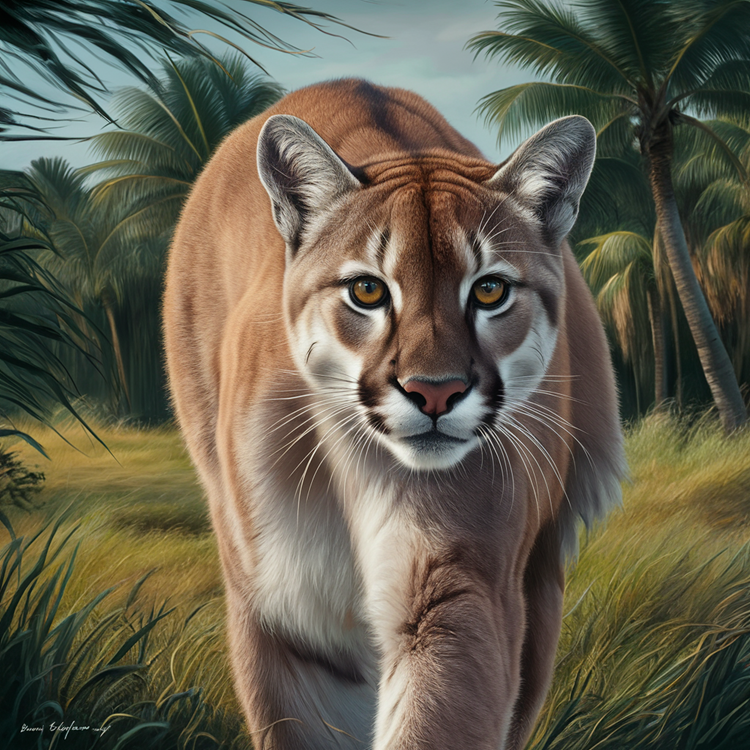
What Do the Florida Panthers Look Like?
Structure
Florida panthers are large, long-tailed cats. They look like giant house cats with lean, muscular bodies and short, tan fur. One of these animals is much bigger than a domestic cat, though. They generally have lean, muscular bodies, rounded heads, and upright ears that are oval at the tip. They also have a long, tan tail with a black tip. A panther’s tail accounts for almost one-third of its entire length. Their long tail acts as a counterweight and helps them keep balance.
Color and Markings
Their color varies from pale or rusty brown on their sides and backs to dull white or cream on their bellies. The backs of their ears, tail tips, and sides of their noses are dark brown to blackish.
Size and Weight
In size, Florida panthers follow Bergmann’s rule in that they are smaller than cougars from the western U.S. and Canada and yet larger than cougars at more southerly latitudes.
Mature male wild Florida panthers weigh from 100 to 160 pounds (45 – 72 kg). On the other hand, female Florida panthers weigh between 70 and 100 pounds (30 – 45 kg). These big cats vary in height from 24 to 28 inches (60 – 70 cm) at the shoulder and range from 6 to 7.2 feet (1.8 – 2.2 m) long from the nose to the tip of the tail. See
Some Characteristics That Set Florida Panthers Apart From Other Cougars
As we discussed in the inbreeding section, Florida panthers live in a small, isolated breeding population. It follows that the diversity in their gene pool is very low. In the absence of genetic diversity, phenotypic traits become less random. In other words, more of a population will share the same traits. A large percentage of Florida panthers have the following traits.
- 88% of all Florida panthers have a right-angle kink at the tip of their tail.
- 94% of all Florida Panthers have a hair whorl or a cowlick in the middle of their back.
- Many Florida Panthers have spots of white fur on the neck and back.
What Do Florida Panthers Eat?
Florida panthers are apex predators in their environment and eat only meat. To survive, they need the equivalent in biomass of one deer or hog per week. In Florida, they prey on the following.
- White-tailed deer
- feral hogs
- raccoons
- armadillos
- birds
- rabbits
- rats and mice
- snakes
- an occasional alligator
Florida Panther Range and Habitat
- Historic Range: Originally, the Florida panther roamed across several southern states, including: Florida, Georgia, Alabama, Mississippi, Louisiana, Arkansas parts of Tennessee and South Carolina.
- Current Range: Today, Florida panthers occupy less than 5% of their historic range, now limited to the Florida peninsula, primarily south of 29 degrees north latitude.
- Male Panthers: Occasionally venture as far north as Georgia.
- Female Panthers: Remain in southern Florida, where the breeding population is located.
- Preferred Habitat: Panthers favor specific habitats in south Florida, including: freshwater swamp forests, pinelands, and tropical hardwood hammocks.
Where to Spot Panthers
Chances of seeing a Florida panther increase in protected areas, such as:
- Big Cypress National Preserve
- Everglades National Park
- Florida Panther National Wildlife Refuge
- Picayune Strand State Forest See
Report Florida Panther Sightings
The Florida Fish and Wildlife Conservation Commission asks the public to help them add to their knowledge base on Florida panthers. You can do this by reporting any sightings of Florida panthers or their tracks to the FFWCC at the highlighted link.
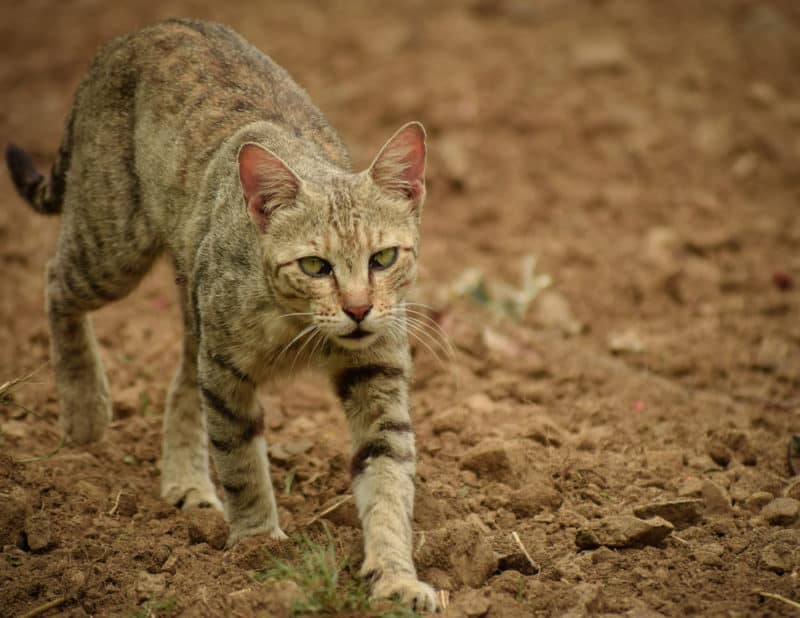
Feral Cats in Florida
The agreeable climate and the abundance of small prey animals make Florida a prime habitat for feral cats. According to the Florida Fish and Wildlife Conservation Commission, the population estimates for feral cats within the state are somewhere between 6.3 and 9.6 million animals. See
This is a major invasive species catastrophe. Feral cat colonies are known in 17 Florida counties. The largest of these colonies numbers over 1,000 animals.
Impact of Feral Cats on Native Wildlife
This substantial feral cat population threatens native wildlife populations. These feline predators take prey animals away from native wild cats. They also spread harmful disease agents such as rabies and Toxoplasma gondii parasite.
The Florida Fish and Wildlife Conservation Commission encourages the state’s cat owners to become responsible and proactive in not contributing to the state’s feral cat problem.
Conclusion
Florida is home to two wild cats, the elusive bobcat, and the endangered Florida panther. Each plays a vital role in the state’s ecosystems. While the bobcat is common throughout the state, the Florida panther remains among the rarest wild cats in the United States. This big feline predator exists today due to conservation efforts to restore its fragile population. Feral cats, though not native, also impact Florida’s environment. They compete with wild species for resources and spread diseases to native wildlife populations.
Preserving Florida’s unique wild cat populations requires ongoing awareness and conservation efforts. By understanding their habitats, behaviors, and threats, residents and visitors alike can help ensure these magnificent creatures continue to thrive in Florida’s natural landscapes. Whether supporting wildlife programs or making responsible choices with pet care, every action counts towards maintaining the delicate balance in Florida’s wild spaces.
Recent Posts
The only venomous snakes in Washington State are Northern Pacific Rattlesnakes. The Northern Pacific Rattlesnake (Crotalus oreganus oreganus) is a sub-species of the Western Rattlesnake. Anyone...
Skunks are not classified as true hibernators. But they go into a state of torpor when the weather gets cold. Skunks are light sleep hibernators, along with opossums, bears, and raccoons. ...

